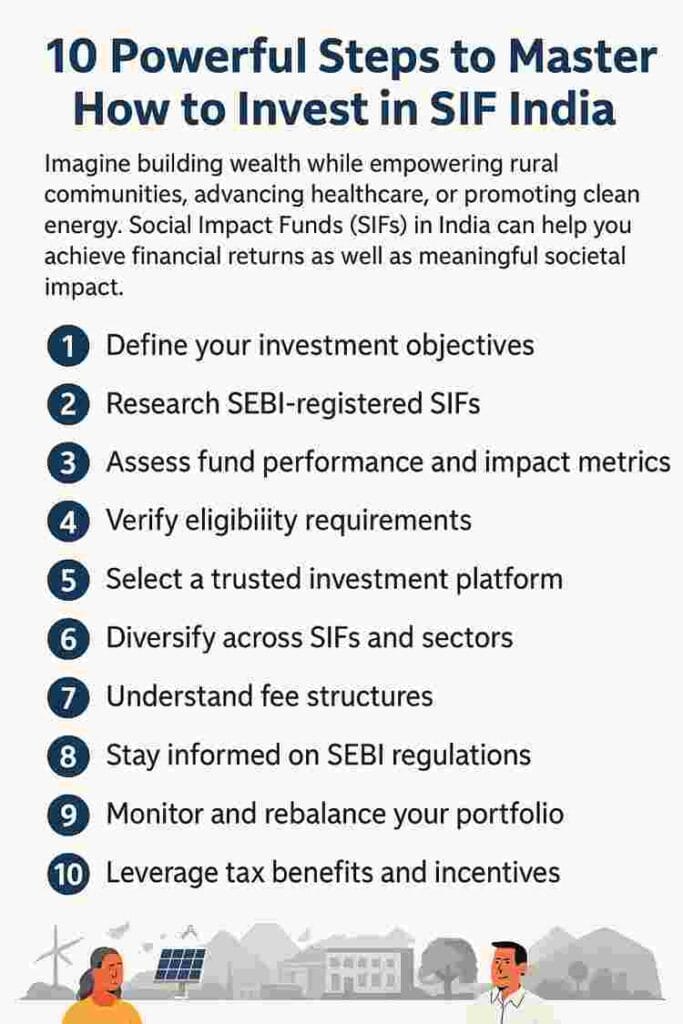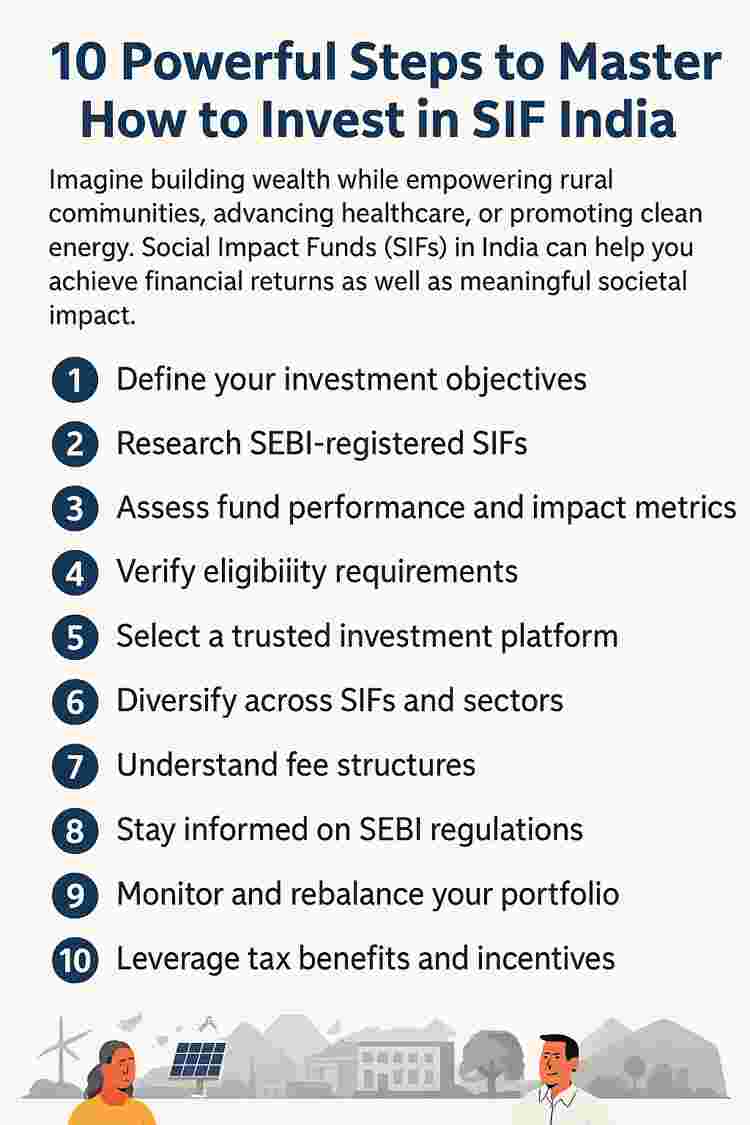Learn how to invest in SIF India with our detailed guide. Discover 10 actionable steps, SEBI regulations, and top strategies to grow wealth while driving social change. Start your journey with confidence today! #how to invest in SIF India, #social impact funds India, #social impact investing India, #SIFs India opportunities, #social impact funds SEBI regulations, #best social impact funds India, #impact investing trends India, #social impact funds for Indian investors, #SIF India beginner guide, #SEBI AIF regulations

Introduction: Why Social Impact Funds Are a Game-Changer for Indian Investors
Imagine increasing wealth while supporting clean energy, improving healthcare, or strengthening rural people. This is made possible in India by Social benefit Funds (SIFs), which combine significant societal benefit with financial profits. Learning how to invest in SIF India has emerged as a potent strategy to match values with profits as Indian investors look for purpose-driven opportunities more and more.SIFs, which are governed by the Securities and Exchange Board of India (SEBI), are becoming more popular. Bain & Company estimates that the impact investing industry would grow to $10 billion by 2027. Beginners and seasoned investors may confidently navigate this exciting new frontier with the help of this comprehensive book, which explains 10 doable stages to master how to invest in SIF India.
Understanding Social Impact Funds (SIFs) in India
Investment vehicles that provide quantifiable environmental or social benefits in addition to financial returns are known as social impact funds, or SIFs. SEBI has designated SIFs as Category I Alternative Investment Funds (AIFs) in India. These funds concentrate on areas that are generally neglected, such as renewable energy, healthcare, education, and agriculture. For instance, money might help women-led businesses or microfinance ventures, fostering advancement and job creation. Understanding the structure, risks, and possible returns of SIF India is essential to knowing how to invest in them.
Why Choose SIFs in India?
India is a great place for impact investing because of its large population, developing internet infrastructure, and socioeconomic difficulties. SIFs appeal to investors who care about social issues because they follow global ESG (Environmental, Social, Governance) trends. They do, however, come with concerns, like extended lock-in periods and volatility in early-stage ventures. Learning how to invest in SIF India requires striking a balance between these risks and the possibility of 8–12% yearly profits as well as a big social impact.
10 Powerful Steps to Invest in SIF India
1. Define Your Investment Objectives
Establish your objectives first. Do you place more importance on financial gains, social impact, or a combination of the two? Establish your investment horizon (e.g., 5–10 years), your risk tolerance, and your favourite industries (e.g., clean energy, rural development). To effectively learn how to invest in SIF India, this clarity is essential.
2. Research SEBI-Registered SIFs
In order to protect investors and maintain transparency, SEBI regulates SIFs under Category I AIFs. For information about registered funds, go to SEBI’s website. Look into funds such as Omidyar Network, which focusses on tech-driven social solutions, or Aavishkaar, which helps rural businesses. When investing in SIF India, one of the most important steps is to research trustworthy funds.
3. Assess Fund Performance and Impact Metrics
Analyse SIFs using social impact metrics like jobs created or communities served, as well as financial performance metrics like historical returns of 8–12%. Because transparency is so important, find out if the fund releases impact reports. Resources like Impact Investors Council offer benchmarks for assessing how to invest in SIF India successfully.
4. Verify Eligibility Requirements
A minimum investment of ₹1 crore is usually required by SIFs, while certain funds allow certified investors to invest at lesser levels. Verify that you fulfil SEBI’s eligibility requirements, which may include reaching certain income or net worth levels. Consulting a financial advisor ensures you’re ready to proceed with how to invest in SIF India.
5. Select a Trusted Investment Platform
Invest directly with fund houses, through fund managers, or through wealth management platforms. Groww and Zerodha are two platforms that may list AIFs, including SIFs. As an alternative, go to Aspen Network of Development Entrepreneurs (ANDE) impact investing events to network with fund providers and discover how to invest in SIF India.
6. Diversify Across SIFs and Sectors
Diversifying your assets across several SIFs or industries, such healthcare, education, and agriculture, can help you reduce risks. Diversification increases your impact and lessens your exposure to risks unique to your industry, such as changes in regulations. Learning how to invest in SIF India requires this approach.
7. Understand Fee Structures
SIFs frequently impose performance fees (e.g., 20% of earnings) and management fees (1% to 2% per year). To prevent surprises, include these in your return computations. Reviewing fee structures is a critical part of learning how to invest in SIF India wisely.
8. Stay Informed on SEBI Regulations
SIF operations are impacted by changes to SEBI’s rules for Category I AIFs. Use SEBI’s official updates or financial news sites such as Economic Times Markets to stay informed. When studying how to invest in SIF India, compliance is ensured by understanding the requirements.
9. Monitor and Rebalance Your Portfolio
Lock-in periods for SIFs are typically five to seven years. Review fund performance on a regular basis using advisor consultations or reports. Rebalance your portfolio if a fund underperforms or your goals change, ensuring alignment with your strategy for how to invest in SIF India.
10. Leverage Tax Benefits and Incentives
Under SEBI or government programs, certain SIFs provide tax advantages, particularly for investments in high-priority industries like renewable energy. When studying how to invest in SIF India, speak with a tax expert to understand more about these benefits, which can increase returns.
Common Mistakes to Avoid When Investing in SIF India
- Skipping Due Diligence: Avoid making investments based only on the social goal of a fund. Check its managerial credentials and financial stability.
- Ignoring Fees: Exorbitant fees might reduce profits. Prior to committing, always review fee arrangements.
- Expecting Quick Returns: SIFs are moderately profitable long-term investments (8–12%). Don’t have irrational expectations.
- Overlooking Impact Metrics: Make sure the fund tracks and discloses social impact because some can put profits ahead of goals.
- Neglecting Diversification: Putting all of your money into one SIF raises your risk. Distribute your assets among different sectors and funds.
The Future of SIFs in India
Thanks to government programs like Digital India and growing interest from retail investors, India’s SIF ecosystem is flourishing. SIFs are now easier to access because to SEBI’s simplified regulations, and money is drawn to global ESG trends. You can achieve financial prosperity and support India’s development by learning how to invest in SIF India.
Conclusion: Take the First Step to Invest in SIF India Today
A special chance to increase wealth and promote constructive change in India is provided by social impact funds. By taking these ten effective actions—setting objectives, investigating SEBI-registered funds, evaluating performance, confirming eligibility, choosing platforms, diversifying, comprehending fees, remaining educated, keeping an eye on investments, and utilising tax advantages—you can confidently master how to invest in SIF India. Steer clear of typical mistakes, keep up of market developments, and become a part of the revolution in Indian investing. Begin your SIF adventure now to access a wealth of profitable, mission-driven opportunities.
FAQs
Q1: What are Social Impact Funds in India?
SIFs are Category I AIFs under SEBI regulation that concentrate on areas like healthcare, education, and rural development and produce both financial returns and social benefit.
Q2: How do I start learning how to invest in SIF India?
Establish your objectives, look for SEBI-registered SIFs, confirm your eligibility, and make your investments through reputable fund managers or platforms.
Q3: What dangers come with SIF investments?
Risks include moderate returns, lengthy lock-in periods, and early-stage venture instability. Due diligence and diversification help to reduce these risks.
Q4: What kind of returns can I anticipate from Indian SIFs?
Annual returns from SIFs range from 8 to 12%, depending on the fund and the state of the market. For clarification, look at past performance.
Q5: Where can I locate SIFs governed by SEBI?
To find registered SIFs, visit SEBI’s website or websites such as Impact Investors Council.
Disclaimer
Risks associated with investing in Social Impact Funds (SIFs) include possible capital loss. There is no guarantee of returns. This post does not provide financial advice; it is merely meant to be informative. Prior to investing, seek advice from a licensed financial counsellor. Verify fund credentials at all times, and make that SEBI laws are followed. The publisher and author disclaim all liability for any losses resulting from investments made using this content.
Also Read:
- How Specialised Investment Fund Impact Investor Positively in 2025
- Benefits of Investing in Gilt Funds in India
- The Ultimate Precious Metals Investment Guide
- Alternative Investment Funds Explained
- The rise of SIFs: A new frontier for Indian investors
- Specialised Investment Funds (SIFs) – Meaning, Benefits & Key Factors

